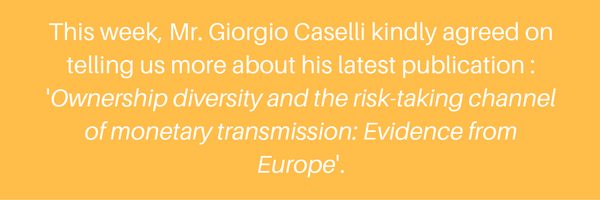
Hello Mr. Caselli, at the EACB we already have to pleasure to know you as the winner of the 4th EACB Award, could you briefly present yourself to our readers ? What brings you to work on the subject of co-operative banking ?
Hello and thank you for inviting me to talk about my latest publication. I am a doctoral researcher in Financial Economics at Cranfield University, UK. My research interests lie in the area of financial intermediation, with a primary focus on the implications of ownership structure for bank behaviour and monetary policy transmission. Before moving to the UK, I grew up in a rural area in the North-East of Italy, where co-operative banks play a major role in providing access to credit, promoting financial inclusion and supporting the local economy. This is also the case in other countries such as Germany, Austria and France, where profit-maximising banks (also referred to as ‘shareholder banks’) operate alongside a considerable number of intermediaries – co-operative banks in the first place – that strive to create value for a larger set of stakeholders (so called ‘stakeholder banks’). Despite this, the cooperative banking model seems to find somewhat little recognition in the academic and policy communities. With my work, I attempt to redress the paucity of research on co-operative banking by exploring how diversity of ownership forms in the European banking sector affects monetary transmission via the risk decisions of financial intermediaries.
In your article, you make parallel between the banking system and the nature biodiversity / ecosystem. Would you say that Co-operative banks are key pieces of the Banking ecosystem ? How do you assess their role ?
Co-operative banks are indeed a key component of the banking ecosystem, inasmuch as they contribute to diversity in banking. A well-accepted view in ecology is that the degree of diversity (or heterogeneity) of an ecosystem can largely influence its dynamics. Ecologists and conservation biologists agree that a community populated by a multiplicity of species is generally more stable than a monoculture. Similarly, we could argue that diversity of ownership structures in the banking industry is beneficial for the stability of the financial system and its resilience to crises. In our latest study, we borrow measures used in ecology to quantify species diversity and use them to compute indices of ownership diversity in banking. Our results, based on a sample of shareholder and stakeholder banks from Western Europe, suggest that financial intermediaries located in more ownership-diverse countries tend to be more stable and to take on less risk following an expansionary monetary policy than intermediaries located in less diverse countries. Taken together, these findings highlight the systemic benefits to be gained from a critical mass of co-operative banks operating alongside other ownership types.
In the actual policy context, what would you say to regulators on the importance of diversity in the Banking sector ? What would be your suggestions to preserve it ?
The results of our research suggest that diversity in banking is an important determinant of financial stability. This evidence complements earlier findings on the contribution of diversity to a range of other outcomes such as financial inclusion, competition and customer choice. For all these reasons, preserving a variety of ownership forms in the banking sector should be raised as a major policy objective. The attainment of such an objective calls for a redesign of the existing regulatory framework so as to grant the co-operative banking model a more prominent role. Particularly key for regulators is to encourage competition between different types of banks (instead of within banks of the same nature) and to promote an even distribution of market shares across ownership structures. At the same time, initiatives aimed at regulating the European banking sector should not damage the diversity of its ownership types. It follows that the main features of co-operative banks should not be impaired by regulatory constraints developed with shareholder banks in mind. I hope our research will stimulate further discussion over the benefits of a biodiverse banking sector for the stability and resilience of the financial system.
Thank you Mr. Caselli. One last question : you wan the 4th EACB Award for young researchers last June, how is the collaboration with the EACB helping you in your research ? Would you recommend it to potential participants to this year call for papers ?
My pleasure. The collaboration with the EACB is helping me in a number of ways. Besides awarding financial support to my research, the opportunity to work closely with the EACB is proving invaluable in bringing visibility to my findings outside of the academic community. This is key if I am to ensure that my research makes an impact on society. Moreover, the collaboration with the EACB is enabling me to engage with researchers and professionals concerned with co-operative banking, thus helping me keep up to date with the most important developments in the field. Therefore, I would highly encourage any young researcher who is working on co-operative banking to submit their research to the 5th EACB Award. When I look back on my experience of winning the EACB Award, I am amazed at the range of opportunities it has offered me. From presenting my research at the European Parliament in Brussels to sharing my findings with experts in co-operative banking, I will always regard the EACB Award as one of the most rewarding and productive experiences of my life as a young researcher. I wish participants best of luck with their submissions and look forward to reading their research.



